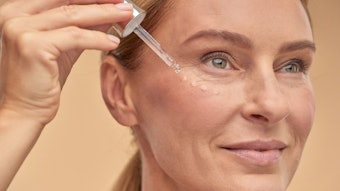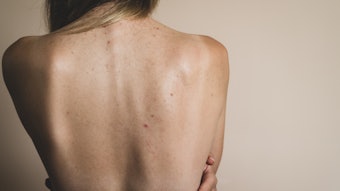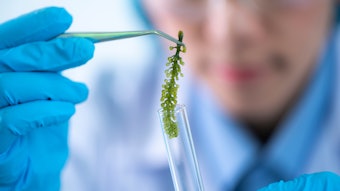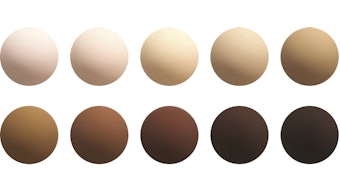Patent Picks are taken from publicly available sources. This edition features patents related to anti-aging and moisturizing compositions and skin care benefits.
Hydroxyalkanoic acid and hydroxyalkanoice acid oligomer esters of retinol for anti-aging
US Patent 8329938
Publication date: Dec. 11, 2012
Assignee: Eastman Chemical Co.
Described by this patent are retinyl hydroxyesters and retinyl oligo-hydroxyesters prepared using a chemoenzymatic process from retinol and short chain esters of hydroxycarboxylic acids. The retinyl ester products are readily enzymatically hydrolyzed in vitro, which indicates that application to the skin should release the anti-aging ingredient retinol, without its inherent instability and irritation issues, along with the acid, which, if chosen appropriately, should also have desirable biological effects. This combination should be effective as an anti-aging skin care ingredient as a lotion, cream, ointment, soap, stick, or the like and, in some cases, provide additional benefits, e.g., by moisturizing the affected skin areas.
Macrocyclic compounds for anti-inflammatory benefits
US Patent 8329742
Publication date: Dec. 11, 2012
Assignee: EISAI Co., Ltd.
The present invention discloses methods for the treatment of various disorders in which compounds are useful as inhibitors of NF-κB activation, AP-1 activation and protein kinases (e.g., MEKK1, MEK1, VEGFr, PDGFr), exhibit antiangiogenic activity, and/or have an anti-anflammatory effect. The compounds also find use in the prevention of restenosis of blood vessels subject to traumas such as angioplasty and stenting, and for preventing or treating UVB-induced photodamage.
Method of preventing photo-aging with ashwagandha and Indian gooseberry
US Patent 8329231
Publication date: Dec. 11, 2012
Assignee: Nutragenesis LLC
This patent covers a method of preventing photo-aging and its related causes that includes administering a therapeutic composition comprising extracts of the plant species ashwagandha (Withania somnifera) and Indian gooseberry (Phyllanthus emblica). Said composition reportedly may: lower cortisol and increase DHEA; prevent free radical-induced photo-aging; inhibit collagenase activity in vitro; inhibit hyaluronidase activity in vitro; display superior cascading antioxidant activity; reduce C-reactive protein; and enhance mood.
Microcrystalline cellulose and calcium phosphate compositions as pharmaceutical excipients
US Patent 8329221
Publication date: Dec.11, 2012
Assignee: FMC Corp.
Coprocessed compositions containing calcium phosphate and microcrystalline cellulose are described herein as useful excipients in the preparation of solid dosage forms containing active pharmaceutical ingredients. Such compositions may be obtained by preparing aqueous slurries of microcrystalline cellulose and calcium phosphate and drying such slurries to produce particulate products. The coprocessed products exhibit improved compactibility, compared with dry physical blends of the same components. The MCC/calcium phosphate-containing materials of the invention may be used as binders in solid dosage forms such as tablets that comprise one or more actives and, optionally, one or more other excipients. Although primarily useful in pharmaceutical and veterinary applications, they may be used in food, cosmetics and other industrial applications.
Cosmetic or dermatological stick
US Patent 8329200
Publication date: Dec. 11, 2012
Assignee: Beiersdorf AG
The present invention is a water-in-oil (w/o) emulsion having high water content and relatively high amounts of skin moisturizing agents and a cosmetic or dermatological stick including said emulsion. The emulsion is solid at room temperature and comprises a fatty phase with at least one oil component and at least one wax component amd an aqueous phase with a skin-moisturizing agent.
Photostabilization of coenzyme Q compounds with alkoxycrylene compounds
US Patent 8329148
Publication date: Dec. 11, 2012
Assignee: Hallstar Innovations Corp.
Described by this invention is a composition and method to reduce the photodegradation of a coenzyme Q10 compound, upon its exposure to UV radiation, using alkoxycrylene compounds. An amount of alkoxycrylene compound is used effective to quench singlet excited state energy from the coenzyme Q10 compound and transfer the singlet excited state energy from the coenzyme Q10 compound, thereby photostabilizing it.
Cosmetic or dermopharmaceutical topical use of a mixture of a GHK tripeptide and GQPR tetrapeptide
WIPO Patent Application WO/2012/164488
Publication date: Dec. 6, 2012
Assignee(s): Sederma, A. Fournial and P. Mondon
The present patent describes a mixture of A-GHK-B tripeptide and A-GQPR-B tetrapeptide (SEQ ID NO: 1), or their derivatives or analogs, for the therapeutical treatment of the papillary dermis to prevent damage to and/or repair the papillary dermis, and prevent and/or treat skin aging, in particular photo-induced aging.
Topical delivery of oligonucleotides to hair follicles
US Patent Application 20120309815
Publication date: Dec. 6, 2012
Assignee: Isis Pharmaceuticals Inc.
Disclosed herein are compositions and methods that enhance the delivery of nucleic acids and other nucleosidic moieties via topical routes of administration. An aqueous solution is described to preferentially deliver nucleic acids to hair follicles with the goal of inhibiting hair growth.










